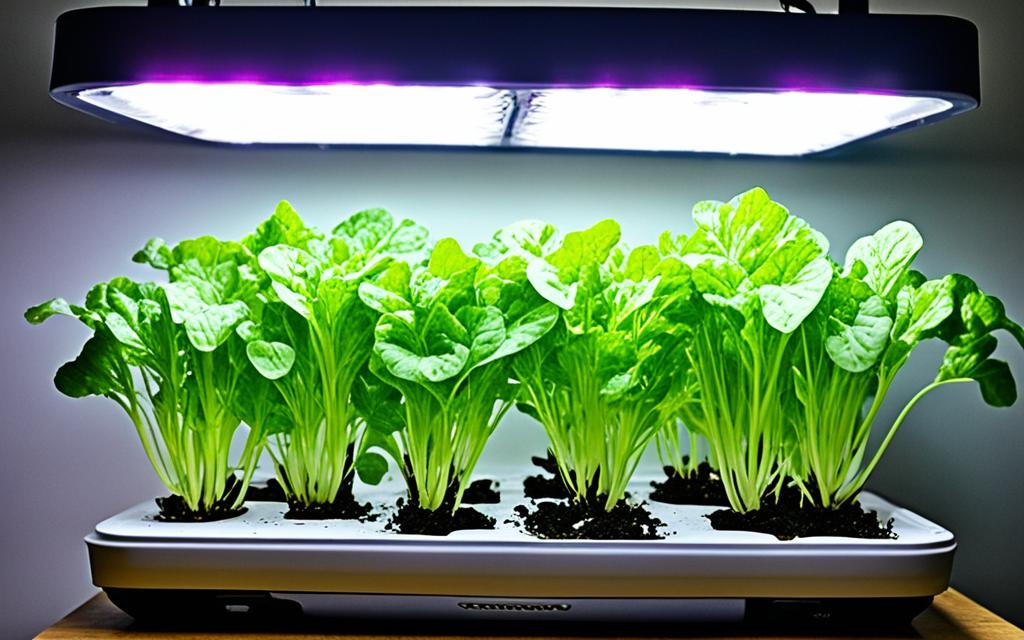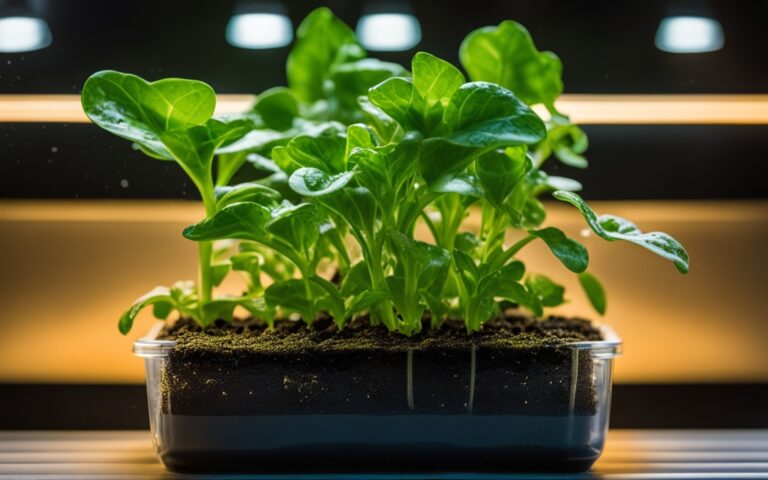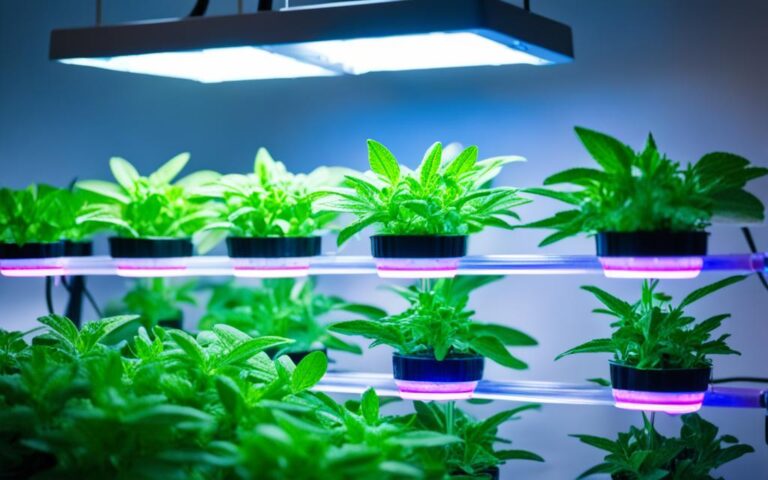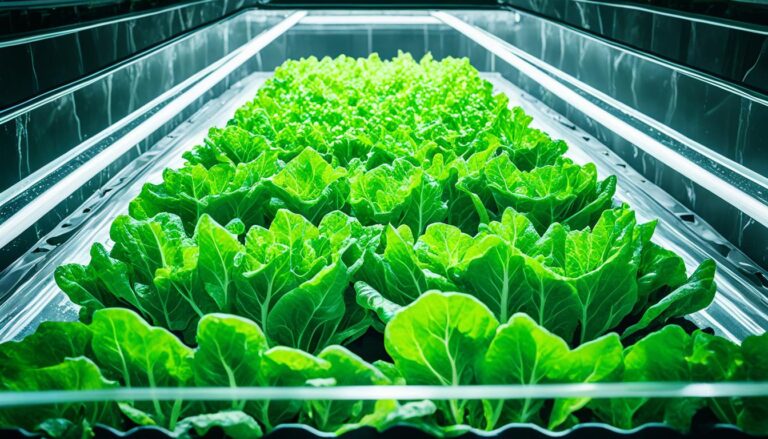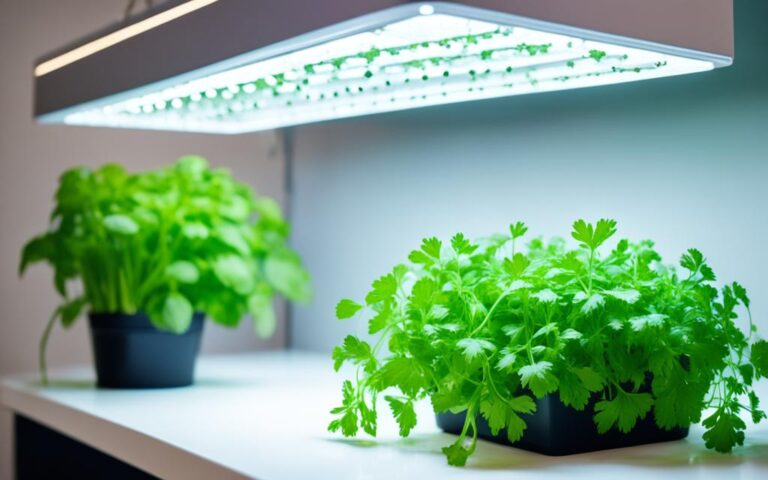Grow Hydroponic Mustard Greens Efficiently
Did you know hydroponic farming can make up to 10 times more leafy greens per square foot than traditional farming? This method is a big leap forward for growing mustard greens all year, even in small indoor spaces. It uses soilless farming and controlled environments to bring out the best in this tasty superfood.
Key Takeaways
- Hydroponic farming can boost mustard green yields by up to 10 times compared to traditional soil-based methods.
- Hydroponic systems enable year-round production and cultivation in compact indoor spaces.
- Precise control over the growing environment optimizes nutrient delivery and plant growth for hydroponic mustard greens.
- Hydroponic cultivation reduces water usage and eliminates the need for pesticides, promoting sustainable agriculture.
- Growing mustard greens hydroponically unlocks their nutrient-dense properties and unique flavors.
Introduction to Hydroponic Mustard Greens
Mustard greens are a favorite among gardeners for their nutrition and ease of growth in hydroponics. They don’t need soil to grow, which makes them perfect for hydroponics. This method helps them grow faster and uses resources well, making them great for both home and commercial gardens.
Benefits of Growing Mustard Greens Hydroponically
Hydroponic systems let you control the growing conditions better. You can adjust the nutrients, temperature, and light for faster growth and more produce. Plus, you don’t need soil, which means fewer pests and diseases, and you can grow all year.
Nutrient and Health Information
Mustard greens are full of important nutrients. They have vitamins K, A, C, and E, plus minerals like copper, calcium, iron, and magnesium. Growing them hydroponically can make sure you get the most nutrients from these tasty leaves.
These greens are also good for your health. They’re full of antioxidants that fight off harmful free radicals and lower the risk of chronic diseases. The fiber in them helps with digestion and keeps your gut healthy.
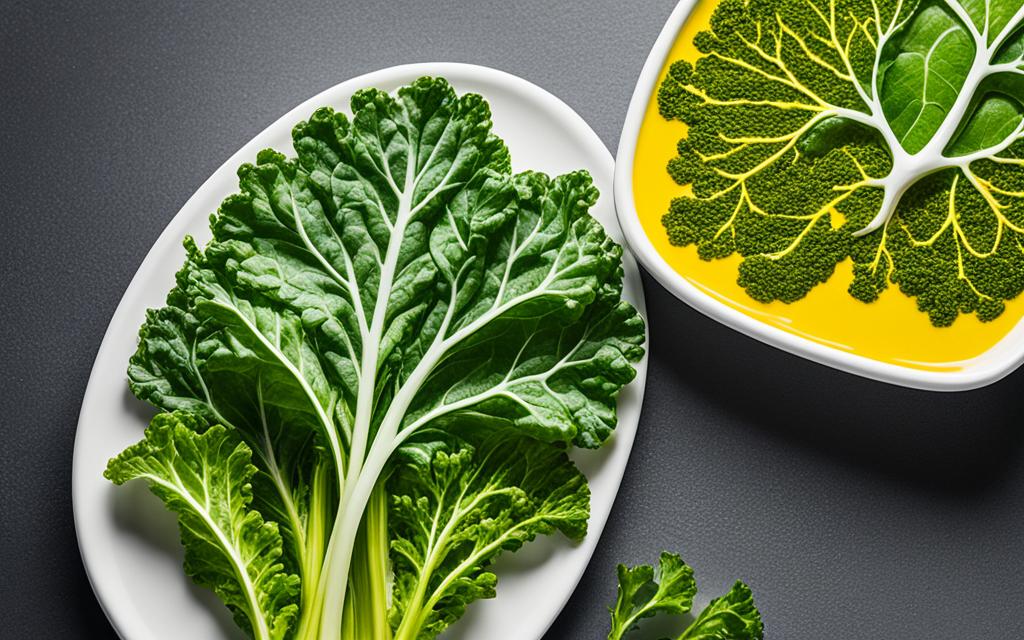
“Mustard greens are a nutrient-dense superfood that can thrive in hydroponic systems, making them an excellent choice for health-conscious growers.”
Selecting the Right Hydroponic System
Choosing the right hydroponic system is key when growing mustard greens. The DWC and NFT systems are top choices for these greens. They both have their benefits and work well for growing hydroponic mustard greens.
Deep Water Culture (DWC) Systems
The DWC system is easy to start with for growing hydroponic mustard greens. It keeps the roots in a solution full of nutrients. This means the plants get water and nutrients all the time. It’s perfect for beginners.
Nutrient Film Technique (NFT) Systems
The NFT system uses a thin film of nutrients that flows through channels. This method gives mustard greens a steady supply of nutrients. It’s great for small spaces because you can stack the channels.
Deciding between DWC and NFT depends on your space, budget, and what you like. Both systems have their perks. They can help you grow a lot of these healthy greens.
Setting Up Your Hydroponic Grow Environment
To grow hydroponic mustard greens, you need the right setup. This means picking the best hydroponic grow setup and keeping a controlled environment for mustard greens. Every part of your grow tent for hydroponics is key to a great harvest.
Here are the main things to think about when setting up your hydroponic grow space:
- Grow Space: Pick a spot that gives your mustard greens enough room to grow without crowding.
- Lighting: Use high-efficiency LED grow lights that give the right kind and amount of light for mustard greens.
- Temperature and Humidity: Keep the temperature steady at 65-75°F and the humidity at 40-60% for the best plant conditions.
- Air Circulation: Make sure there’s enough air movement to help your plants grow strong and avoid stagnant air.
By designing your hydroponic grow setup and controlling the environment for mustard greens in your grow tent for hydroponics, you’re on your way to a successful crop.
| Factor | Optimal Range |
|---|---|
| Temperature | 65-75°F |
| Relative Humidity | 40-60% |
| Lighting | High-efficiency LED grow lights |
| Air Circulation | Adequate air movement |
“The key to successful hydroponic mustard green cultivation lies in creating an environment that closely mimics their natural growing conditions.”
Choosing the Best Mustard Green Varieties
Choosing the right mustard green varieties is key to a great hydroponic harvest. Not all types are perfect for hydroponics. It’s important to pick ones that do well in this setup.
Popular Hydroponic Mustard Green Cultivars
Here are some top mustard green varieties for hydroponics:
- Red Giant – It has bright red-purple leaves, grows fast, and fights off diseases well. This makes it a great choice for hydroponics.
- Green Wave – This type has big, green leaves with a spicy taste. It loves the nutrient-rich hydroponic environment.
- Southern Giant Curled – A classic with deep, crinkly leaves that’s great for hydroponics. It tastes bold and spicy.
These best mustard green varieties for hydroponics are loved for their quick growth and great taste. They’re perfect for growing indoors in a controlled setting.
“Selecting the right mustard green cultivars is essential for successful hydroponic gardening. The varieties that excel in this environment offer the best combination of yield, flavor, and disease resistance.”
Germination and Seedling Care
Starting your hydroponic mustard green crop right is key. Begin by sowing mustard green seeds in a good medium like rockwool cubes or seed trays. It’s important to create the right environment for your hydroponic mustard green seedlings to grow strong and healthy.
Keep the temperature, humidity, and light just right during germination and the early stages. This helps the mustard greens grow their first leaves fast. Once they have these leaves, you can move them to the hydroponic system. There, they’ll get the right nutrients and conditions to keep growing well.
- Sow mustard green seeds in a suitable medium (e.g., rockwool cubes, seed trays)
- Provide optimal temperature, humidity, and lighting for germination and seedling growth
- Monitor seedlings closely and transplant into the hydroponic system once they develop first true leaves
| Germination Requirements | Seedling Care |
|---|---|
|
|
By following these steps for germinating mustard greens hydroponically and taking good care of your hydroponic mustard green seedlings, you’ll be on your way to a successful crop.
Transplanting and Maintaining Optimal Growth
After the seedling stage, it’s time to move your hydroponic mustard greens to their final spot. Make sure to space them right so the roots can reach the nutrient solution easily. Keeping the right lighting requirements, temperature, and humidity levels is key for your plants to grow well.
Lighting Requirements
Mustard greens need 14-16 hours of light each day. Give them strong, quality light to help them grow big and healthy. LED or high-efficiency fluorescent lights are great for hydroponics.
Temperature and Humidity
The best temperature for hydroponic mustard greens is 68-72°F. This temperature helps them grow well. Also, keep the humidity between 50-70%. Watch and adjust the environment to make sure your transplanted mustard greens are happy.
| Environmental Factor | Optimal Range |
|---|---|
| Lighting | 14-16 hours per day |
| Temperature | 68-72°F |
| Humidity | 50-70% relative humidity |
By keeping an eye on and adjusting these factors, you can help your hydroponic mustard greens grow to their best. This will give you a great harvest.
Nutrient Management for Hydroponic Mustard Greens
For hydroponic mustard greens to grow well, it’s key to manage nutrients right. The nutrient solution must have the right mix of nitrogen, phosphorus, and potassium, plus trace minerals. Keeping the pH levels between 5.5 and 6.8 makes sure plants get the nutrients they need.
Checking and tweaking the nutrient solution often helps your mustard greens grow strong. Knowing what nutrients they need and keeping the pH levels right for hydroponic mustard greens makes for a great growing space. This leads to healthy plants and lots of harvests.
Essential Nutrients and pH Levels
- Nitrogen (N) – Promotes healthy leaf growth and development.
- Phosphorus (P) – Supports root development and overall plant vigor.
- Potassium (K) – Enhances disease resistance and stress tolerance.
- Trace minerals – Include iron, calcium, magnesium, and others for overall plant health.
| Nutrient | Optimal Range for Hydroponic Mustard Greens |
|---|---|
| Nitrogen (N) | 100-200 ppm |
| Phosphorus (P) | 40-80 ppm |
| Potassium (K) | 100-200 ppm |
| pH | 5.5-6.8 |
Getting the nutrient solution and pH levels right is key for hydroponic mustard greens. By keeping an eye on and adjusting these, you make sure your plants get what they need to do well.
Pruning and Harvesting Techniques
Growing hydroponic mustard greens is rewarding, and knowing how to prune and harvest is key. These greens do well when you cut the older leaves, which makes room for new ones to grow. This way, you get to enjoy fresh greens over a longer period.
When pruning, use sharp scissors or knives to cut the older leaves at the base. Make sure to leave the stem and core. This helps the plant focus on making new leaves. You’ll get a steady supply of tasty greens all season.
- Prune the outer, mature leaves regularly to encourage continued growth
- Leave the plant’s stem and core intact to allow for regrowth
- Use clean, sharp tools to ensure a clean cut and minimize damage to the plant
Harvesting is easy. Just pick the leaves you want and cut them at the base with clean scissors or knives. Leave the core alone. This method lets the plant keep growing, giving you more harvests from the same plants.
“Proper pruning and harvesting techniques are the keys to a bountiful hydroponic mustard green harvest.”
By pruning and harvesting your hydroponic mustard greens the right way, you’ll have a steady supply of fresh leaves. Always be gentle with your plants, and they’ll give you a lot of delicious greens.
Identifying and Addressing Common Issues
Even the best hydroponic gardeners face challenges with mustard greens. Nutrient shortages and pests or diseases can hurt your plants’ health and yield.
Nutrient Deficiencies and Solutions
Mustard greens may show signs of nutrient lack, like yellow leaves from not enough nitrogen or slow growth from too little phosphorus or potassium. Keep an eye on your hydroponic solution’s nutrient levels. Add more of what’s missing to fix the balance and help your plants grow well.
Pest and Disease Management
Pests and diseases can trouble hydroponic mustard green growers. Use organic neem oil sprays or beneficial insects to stop problems before they start. Check your plants often and act fast if you see any issues to keep your crop healthy and productive.
| Common Issues | Symptoms | Solutions |
|---|---|---|
| Nitrogen Deficiency | Yellowing of older leaves | Increase nitrogen levels in nutrient solution |
| Aphid Infestation | Curled, distorted leaves; sticky honeydew | Use organic neem oil spray; introduce beneficial insects |
| Powdery Mildew | White, powdery growth on leaves | Increase air circulation; use organic fungicide |
Stay alert and fix problems quickly to keep your hydroponic mustard greens healthy and productive.
Hydroponic Mustard Greens for Maximum Yield
Getting the most out of your hydroponic mustard greens is crucial for a great harvest. By making your hydroponic system and growing methods better, you can get the best from these tasty and healthy greens.
Keeping the right nutrient solution is key to high yields. Make sure to check and adjust the pH and nutrients like nitrogen, phosphorus, and potassium. This ensures your plants get what they need to grow well. Maximizing yield of hydroponic mustard greens means giving them the best conditions to grow.
Good lighting is also vital for growing lots of hydroponic mustard greens. Make sure your plants get enough light that’s strong and lasts long. This helps them grow and produce more.
| Factors for Maximizing Yield | Best Practices |
|---|---|
| Nutrient Management |
|
| Lighting Requirements |
|
| Pruning and Harvesting |
|
Hydroponics lets you grow year-round and use space well, boosting your high-yielding hydroponic mustard green systems. With the right methods, you can always have a lot of these tasty and healthy greens.
“Maximizing yield is the key to a successful hydroponic mustard green operation. By optimizing your growing practices, you can unlock the full potential of these versatile and nutrient-rich greens.”
Companion Planting in Hydroponic Systems
Hydroponic gardening lets us explore the perks of companion planting. By growing different crops together, we can use space better, increase productivity, and make our gardens more diverse and strong.
Mustard greens and other leafy greens like kale, Swiss chard, or arugula work well together in hydroponics. They share nutrients and resources, helping each other grow. This pairing is great for hydroponic companion planting.
Herbs like basil or mint are also good with mustard greens in hydroponic polyculture. These plants help each other by fighting pests and getting nutrients better. This makes the hydroponic system more balanced.
“Intercropping in hydroponic gardens can lead to significant increases in yield and resource efficiency, making it a valuable strategy for small-scale growers and urban farmers.”
Using companion planting in hydroponic systems boosts productivity and sustainability. It helps use space well, controls pests naturally, and creates a healthy hydroponic garden.
Conclusion
Growing hydroponic mustard greens is a rewarding way to get nutritious and tasty leafy greens. By picking the right hydroponic system and keeping the right nutrient management, you can have a lot of fresh, homegrown mustard greens all year.
It doesn’t matter if you’re new or have been doing hydroponic gardening for a while. Adding mustard greens to your setup is a tasty and fulfilling project. The perks of growing mustard greens hydroponically are many. You get a steady supply of healthy food, it’s good for the planet, and you feel great growing your own food.
This guide has given you the tools to make the most of hydroponic mustard greens. With these tips, you can create a garden that’s good for you and the earth.
